2014 年 6 月大学英语三级 B 真题及答案
(总分 100, 考试时间 120 分钟)
Part I Listening Comprehension (15 minutes)
Directions: This part is to test your listening ability. It consists of 3 sections.
Section A
Directions: This section is to test your ability to give proper answers to questions.
There are 5 recorded
1.
B
C
D
My pleasure.
Thank you very much.
Yes, but he's not in.
Quite a lot.
A
答案:D
[听力原文]
Hello! Is this your manager's office?
本题考查对一般疑问句的回答。问题为“你好!这里是你们经理的办公室吗?”D 项 Yes, but
he's not in(是,但他不在)是肯定回答,故正确。
一般疑问句的肯定回答用 Yes,否定回答用 No。A 项 Quite a lot(很多)用于回答 how many
或 how much 开头的特殊疑问句。B 项 My pleasure(是我的荣幸)是对感谢用语的客气回答。
C 项 Thank you very much(非常感谢)表示感谢。
2.
B
C
D
Yes, I do.
See you later.
Fine, thanks.
Wait a minute.
A
答案:B
[听力原文]
Do you have an appointment with Mr. Brown?
本题考查对一般疑问句的回答。句子意思是“你跟布朗先生约好了吗?”have an appointment
with sb.意为“与某人有预约”。本句的助动词是 do,故肯定回答是 B 项 Yes, I do(是的)。
A 项 Wait a minute(等一下)是对请求或要求的回答。C 项 See you later(待会儿见)是在道
别时使用。D 项 Fine, thanks(很好,谢谢)一般用于回答 How are you 或 How are you doing
等问候语。
3.
B
C
D
Mind your step.
Very much.
So am I.
Take it easy.
A
答案:C
[听力原文]
Do you like your new job in this small town?
本题也是一般疑问句。句子意思是“你喜欢这座小镇上的新工作吗?”C 项 Very much(非常)
为肯定表达,故正确。
�
A 项 Take it easy(别紧张,放轻松)用于安抚对方。B 项 Mind your step(留心脚步;走好,
慢走)是让对方注意脚下安全,或作为道别时的客气话,如:Mind your step, Thank you for
coming.(慢走,感谢您的光临。)D 项 So am I(我也是)表明前面所说情况也同样适用于自己。
4.
B
C
D
No, thanks.
Here we are.
Can I help you?
At 16:30.
A
答案:A
[听力原文]
When is the train leaving for Beijing?
本题考查对 when 特殊疑问句的回答。题目的意思是“火车什么时候出发去北京?”句子开头
的 when 表示时间,A 项 At 16:30 是具体的时间点,直接回答了该问题。
B 项 No, thanks(不用,谢谢)是对帮助或给予的否定回答。C 项 Here we are(我们到了)暗
示该下车、船或飞机等。D 项 can I help you?(我能帮你吗?)用于提出帮助,不能回答 when
问句。
5.
B
C
D
Sure. Here it is.
It's far away.
Take care.
This way, please.
A
答案:B
[听力原文]
May I see your driving license, please?
本题是表示请求的一般疑问句。问题意为“请问我可以看一下你的驾照吗?”B 项 Sure. Here
it is(当然。给你)是肯定回答。
A 项 This way, please(请走这边)是给人指路的常用语。C 项 It's far away(很远)表示距
离远。D 项 Take care(保重;当心)一般用于跟别人道别。
Section B
Directions: This section is to test your ability to understand short dialogues. There
are 5 recorded dialogues in it. After each dialogue, there is a recorded question.
The dialogues and questions will be spoken two times. When you hear a quest
6.A
B
C
D
Give up his plan.
Get a new job.
Put forward a suggestion.
Find a new apartment.
答案:C
[听力原文]
W: When are you going to take the new job!
M: As soon as possible.
Q: What is the man going to do?
事实细节题。题目问男士将要做什么。对话开头女士问:“你什么时候去接手新工作?”男士
回答:“越快越好。”C 项 Get a new job 与女士话语中的 take the new job 同义,get 和
�
take 都表示“获取”。
A 项 Find a new apartment(找新公寓)中的 apartment 没有在对话中提及。男士用 as soon
as possible 表示会尽快去做,故 B 项 Give up his plan(放弃计划)不对。D 项 Put forward
a suggestion(提出一项建议)与对话无关。
7.A
B
C
D
An engineer.
A student leader.
A social worker.
A professor.
答案:A
[听力原文]
W: Do you know who will give a lecture this afternoon?
M: A professor from New York University.
Q: Who will give the lecture?
事实细节题。题目询问谁会来讲课。对话开头女士也问了这个问题:“你知道今天下午是谁
来讲课吗?”男士回答:“纽约大学的一个教授。”A 项 A professor 是男士回答中的原话。
故为答案。
B 项 An engineer(工程师)、C 项 A student leader(学生领袖)和 D 项 A social worker(社
工)在对话中均未提及,故可排除。
8.A
B
C
D
He has a headache.
He has broken his arm.
He got a heart attack.
He took the wrong medicine.
答案:B
[听力原文]
W: You don't look well. What's wrong with you?
M: I've got a headache with a slight fever.
Q: What's the problem with the man?
事实细节题。题目问男士有什么问题。这个问题在对话开头女士也问了:“你看起来不太好。
怎么啦?”男士回答:“我头痛,而且有点轻烧。”故 B 项 He has a headache(他头痛)为答
案。
A 项 He took the wrong medicine(他吃错了)、C 项 He has broken his arm(他摔伤了手臂)
和 D 项 He got a heart attack(他有心脏病)都与对话中提供的信息不符。
9.A
B
C
D
German.
Japanese.
Spanish.
French.
答案:D
[听力原文]
M: I don't know which language I should learn, Japanese, French or German?
W: If I were you, I'd learn French.
Q: What language does the woman advise the man to learn?
�
He has been ill for days.
He is short of money.
He lost his credit card.
事实细节题。题目询问女士建议男士学什么语言。对话中男士问:“我不知道应该学哪门语
言,日语、法语或德语?”女士用虚拟语气回答:“如果我是你,就会学法语。”虚拟语气可
表建议,故答案选择 D 项 French(法语)。
A 项 German(德语)和 B 项 Japanese(日语)处于男士的考虑范围之内,但不是女士的建议。C
项 Spanish(西班牙语)在对话中没有提到。
10.A He is out of work.
B
C
D
答案:A
[听力原文]
M: Tom looks worried. What has happened to him?
W: He has lost his job.
Q: What has happened to Tom?
事实细节题。本题询问 Tom 发生了什么事。对话中男士说:“Tom 看起来很忧心。他发生什
么事了?”女士回答:“他失业了。”A 项 He is out of job 是 He has lost his job 的同义
替换,故为答案。
B 项 He has been ill for days(他病了几天了)C 项 He is short of money(他缺钱)和 D
项 He lost his credit card(他丢了信用卡)都没有在对话中提到。
Section C
Directions: In this section you will hear a short recorded passage. The passage has
some words or phrases missing. The passage will be read three times. During the second
reading, you are required to put the missing words or phrases on the blan
is how
Looking for an apartment can be a difficult job. The first thing to
. Secondly, where
much money you can spend. You cannot rent a home if it's too
(12)
the home is located is also important. You don't want a home too
(13)
from work.
You might want to spend a little more money to be closer to y6ur office. Anyway,
before you look for a place to live in, you should
of all the things you
want and need. This will be easier for you to make the
11.答案:think about
[听力原文]
Looking for an apartment can be a difficult job. The first thing to think about is
how much money you can spend. You cannot rent a home if it's too expensive. Secondly,
where the home is located is also important. You don't want a home too far away from
work. You might want to spend a little more money to be closer to y6ur office. Anyway,
before you look for a place to live in, you should make a list of all the things
you want and need. This will be easier for you to make the correct choice.
(11)
(14)
(15) .
空格前是不定式标志词 to,故应填入动词原形,修饰 The first thing(第一件事)。think
about 意为“考虑”。
12.答案:expensive
空格位于句末,前面的程度副词 too(太)表明应填入形容词,作从句的表语。expensive 意
为“贵的”。
�
13.答案:far away
空格前的程度副词 too(太)表明应填入形容词。上一句提到房子的位置很重要(where the
home is located),故本句与位置相关。结合录音,填入 far away“远离”。
14.答案:make a list
由空格前的情态动词 should 可知此处应填入动词原形,充当句子谓语。make a list 意为
“列清单”。
15.答案:correct choice
空格前的 the 表明此处应填入名词,作 make 的宾语。correct choice 意为“正确的选择”。
Part Ⅱ Vocabulary and Structure (15 minutes)
Directions: This part is to test your ability to construct grammatically correct
sentences. It consists of 2 sections.
Section A
Directions: In this section, there are 10 incomplete sentences. You ar
16.You can ask these experts ______ advice in job hunting.
A
B
C
D
on
over
from
for
答案:D
本题考查介词辨析。空格后的 advice 表明了 ask these experts(请求这些专家)的目的,
故填入 D 项介词 for“为了”。
ask for advice 是习惯搭配,意为“征询意见”。A 项 on、B 项 over、C 项 from 都不符合该
用法要求。
17.If you want to get there before dark, you should start your journey ______.
A
B
C
D
at times
at once
in person
in detail
答案:B
本题考查短语辨析。第一个分句是 if 引导的条件状语从句,根据 get there before dark(天
黑前到达),可知时间紧迫,故填入 B 项 at once“马上”。
A 项 at times“有时,不时”,C 项 in person“亲自”,D 项 in detail“详细地”,代入空
格后都不符合上下文逻辑。
18.The play was so boring ______ I could hardly keep myself from falling asleep.
A
B
C
D
that
which
what
whether
�
答案:A
本题考查从句引导词。空格前有 so(如此),空格后的句子结构完整,“睡着”是“演出无聊”
导致的后果。固定结构 so...that 表示“如此……以至于”,引导结果状语从句。故填入 A
项 that。
除了 so...that 结构,还有 such...that,不同之处是 so 后面接形容词,such 后面接名词。
19.We hope that our customers can ______ advantage of this new service.
A
B
C
D
have
carry
take
bring
答案:C
本题考查习惯搭配的用法。take advantage of 意为“利用”,所以 C 项正确。
A 项 have 与 have 与 advantage“优势,好处”的搭配为 have an/the advantage over“胜
过,优于”,或 have the advantage of“有……的优势”。B 项 carry“携带”和 D 项 bring
“带来”都不与 advantage 搭配。
20.The unemployment rate has become much lower ______ the government took these
measures.
A
B
C
D
but
since
if
while
答案:B
本题考查从句引导词。主句用了现在完成时 has become,从句用了一般过去时 took,表明
从句“采取措施”的动作发生在主句“变得”之前。B 项“自从”符合句意及要求。
A 项 but“但是”表转折。C 项 if“如果”表条件或假设;填入空格后语义逻辑都不对。D
项 while“当……时,这时”表示时间,但主从句的动作不可能是同时发生的,不符合本句
语境。
21.The rope is not strong enough to ______ the weight of the big case.
A
B
C
D
conduct
produce
make
support
答案:D
本题考查动词辨析。空格前提到绳子不牢,enough to 不定式表结果,结果就是支撑不起大
箱子的重量。D 项 support“支撑”与 weight 搭配正确,为答案。
A 项 conduct“引导;管理”B 项 produce“制造,生产”,C 项 make“使变为……;制造”
与 weight 搭配,语义逻辑都不通。
22.He attended school in England for several years, after ______ he returned home.
A
B
what
that
�
C
D
which
whom
答案:C
本题考查非限制性定语从句引导词。空格前后都是完整的句子,推测其中一个是从句。从句
意逻辑上说,returned home(返回家)的动作应该在 attended school(上学)之后,故可判
断空格处填入的词要指代上文。C 项 which 可与介词搭配引导非限制性定语从句。故正确。
A 项 what 引导名词性从句,且一般在从句中充当一定成份。B 项 that 也可以指代上文,但
是本句的两个分句间用的是逗号,如果填入 that,则没有主从句之分,需要用分号连接两
句。D 项 whom 指人,不符合此处语境。
23.You can trust our product as we have ______ control over its quality.
A
B
C
D
strict
limited
little
natural
答案:A
本题考查形容词辨析。句子中含有 as“因为”引导的原因状语从句,主句中 trust out
product(信任我们的产品)表明产品质量是好的,故“质量控制”应该是 strict“严格的”,
故 A 项正确。
B 项 limited“有限的”和 C 项 little“几乎没有的”都表示对质量的控制很少,这不能带
来让对方信任的结果。D 项 natural“自然的”,也不能达到让对方信任的程度。
24.A new study finds out that a kid can learn without ______ what he is doing.
A
B
C
D
realize
realized
realizing
to realize
答案:C
本题考查动名词用法。空格前的 without 是介词,表示“没有,如果没有”,后面应该填入
名词。realize“意识到”是动词,故需使用 C 项动名词 realizing。
介词后需要接代词或名词性成分。如果后跟动词,动词则需要变成动名词。
25.______ last year, traffic accidents have decreased by 10% this year.
A
B
C
D
Related to
Compared with
Concerned about
Dealt with
答案:B
本题考查动词词组的辨析。四个选项都用了过去分词形式,与句子主语 traffic accidents
之间是被动关系,这里是将今年的交通事故情况与去年的作比较,compare with 意为“与……
相比”,符合句义。
A 项 relate to“与……有关”,C 项 concern about“担心”以及 D 项 deal with“处理”
填入此处均语义不通。
�
Section B
Directions: There are 10 incomplete statements here. You should fill in each bland
with the proper form of the word given in the brackets.
26.You'd better make a phone call (check) ______ whether the email has been received.
答案:to check
考查不定式的用法。空格前 make a phone call 是句子谓语动词及宾语,主干已完整;空格
后是 whether 引导的从句,从意义上可判断是动词 check 的宾语,故此处的 check 应用非谓
语动词形式。“打电话”是为了“核实是否收到电子邮件”,故填入表目的的不定式结构 to
check。
不定式表目的通常是指发生在谓语动作之后的动作,也就是说,若以谓语动作发生的时间为
标准,用作目的状语的不定式是一个尚未发生的动作。如本句中 check 的动作发生在 make a
phone call 这个动作之后。
27.We had been working for almost 16 hours, and we (final) ______ finished the task.
答案:finally
考查形容词和副词的转换。空格在主语 we 和谓语动词 finished 之间,故应该填入副词。final
“最终的”变成副词是 finally“终于,最终”。
形容词转变成副词的规则:①一般情况下直接加-ly,如 traditional(传统的)—
traditionally(传统地),wide(宽的)—widely(宽地).②以 y 结尾的,先将 y 改成 i,再
加-ly,如 happy(幸福的)—happily(幸福地);③少数以 e 结尾的形容词,要去掉 e 再加-ly,
如 true(真实的)—truly(真实地)。
28.The Prize in Economics (establish) ______ in 1968, that is, more than half a
century ago.
答案:was established
考查被动语态的用法。空格前的主语中心词是 Prize,空格后是表时间的介词短语,以及插
入语 that is,用于引出 1968 的同位语,进一步解释这个年份。因此句子缺少谓语动词,
establish“建立,设立”的动作是由某人或某机构发出的,主语“经济学奖”是这个动作
的承受者,故应该使用被动语态。由于 1968 是表过去的时间,本句时态用一般过去时;由
于主语 The Prize 是第三人称单数,因此填入 was established。
当句子的主语是谓语动作的承受者时,谓语应用被动语态“be 动词+过去分词”。
29.He is thinking of (leave) ______ his job and going to Germany for further study.
答案:leaving
考查介词的用法。空格前的 is thinking of 是句子谓语部分,其中介词 of 后必须跟代词或
名词性成分。故需把动词 leave 转换成动名词 leaving。
本题考查的是“介词+动名词”的结构。一般来说,介词后面接动词时,动词采用-ing 形式。
30.Most people attending his lecture have found that they have learned something
(use) ______.
�
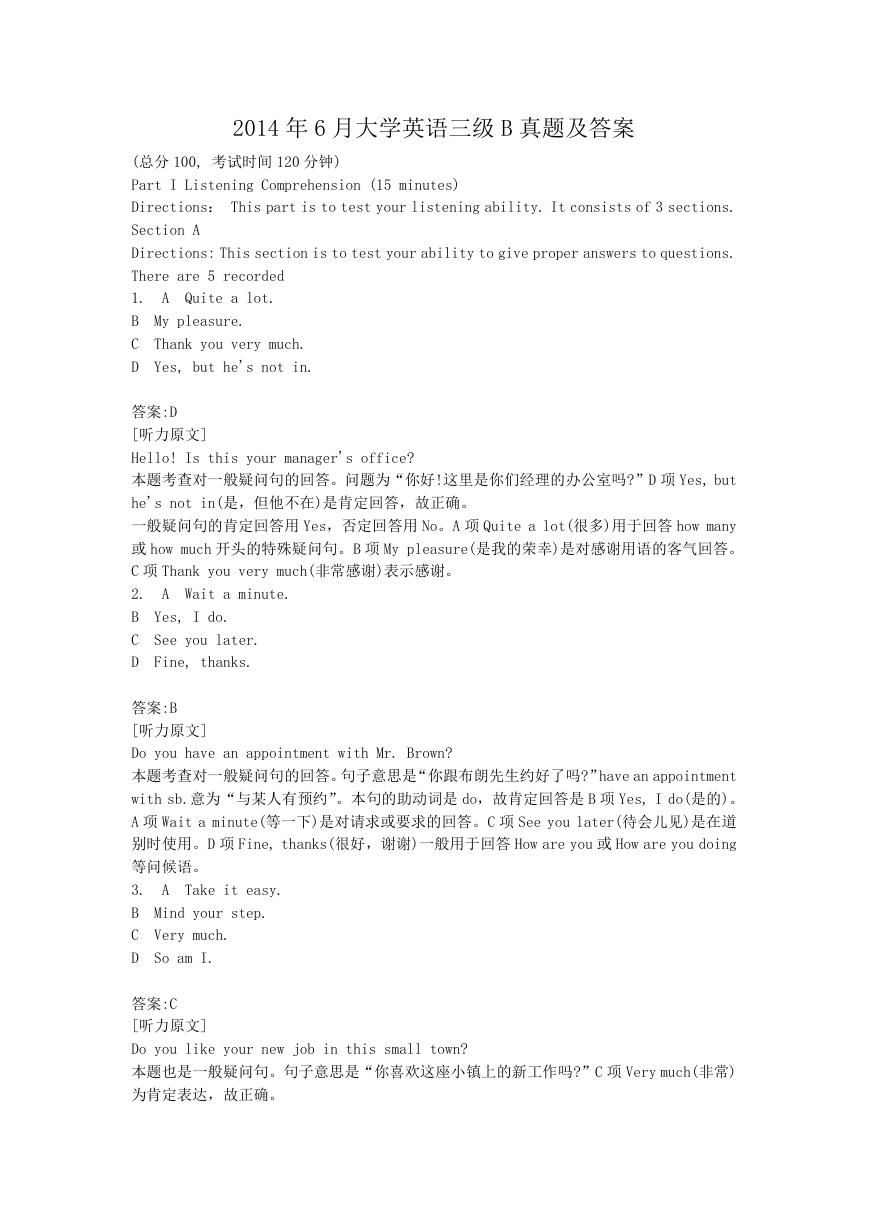
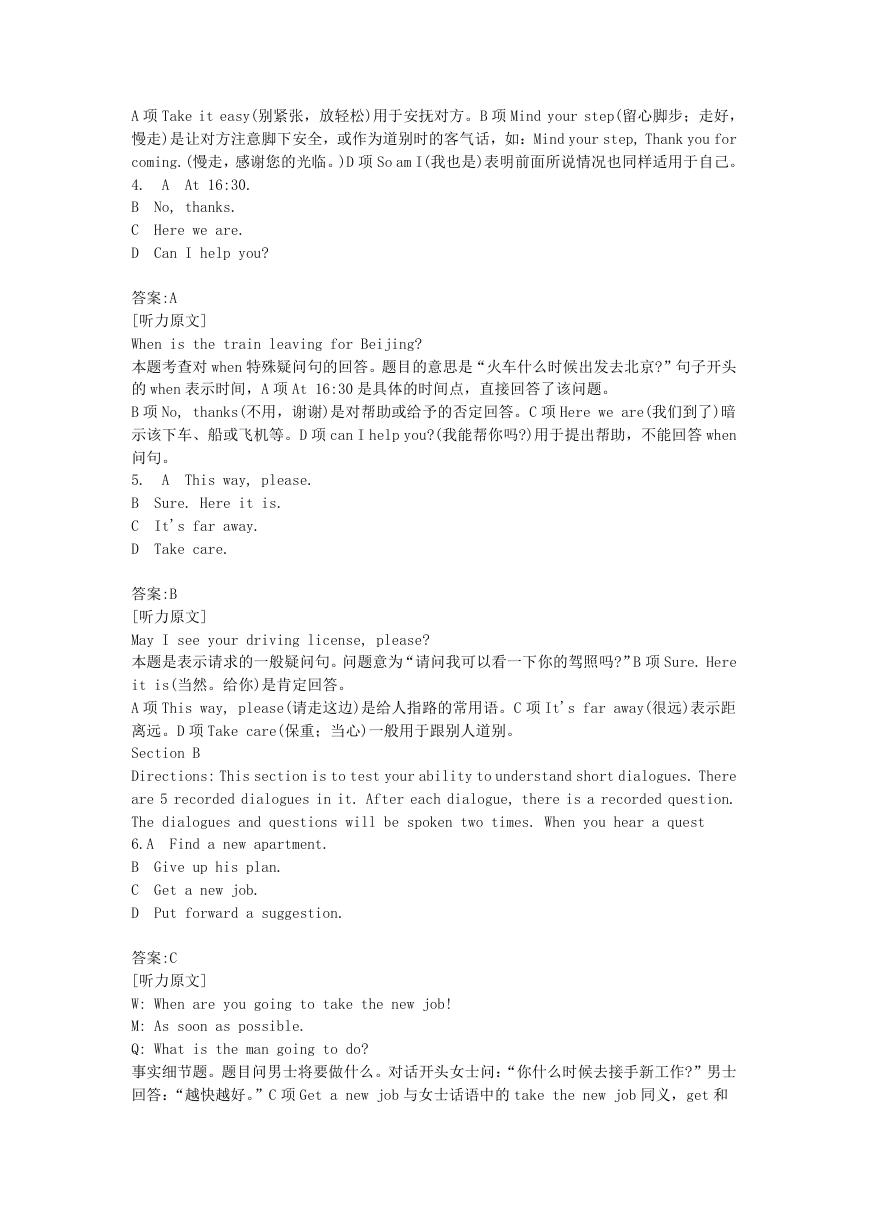
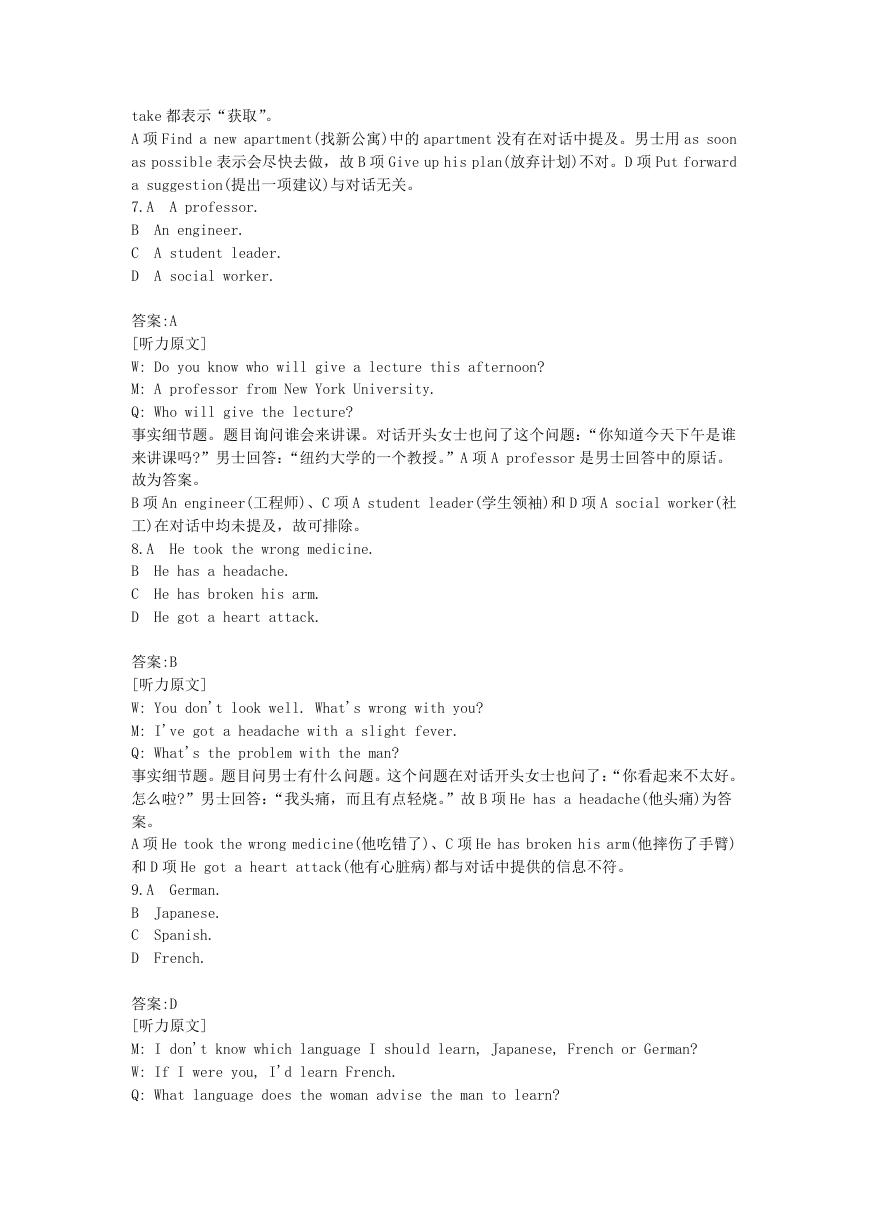
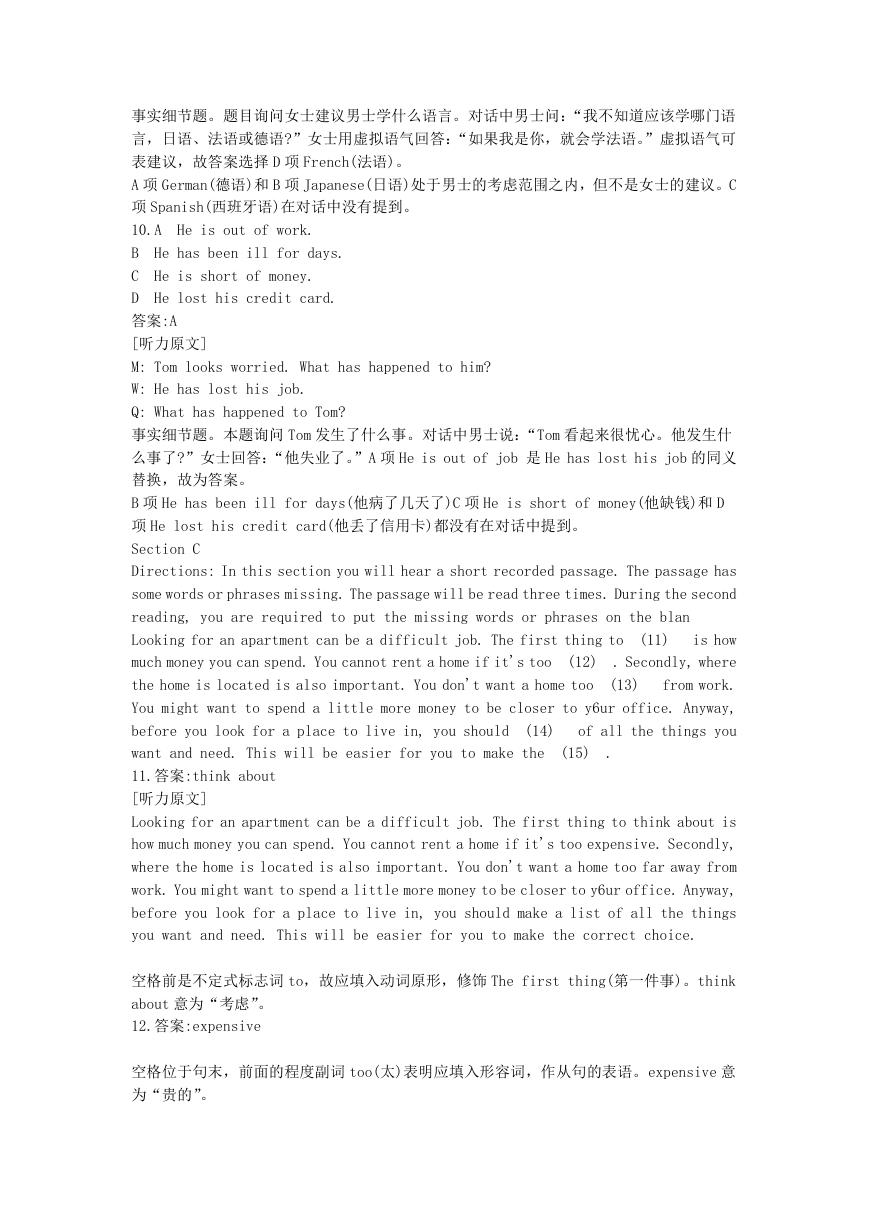


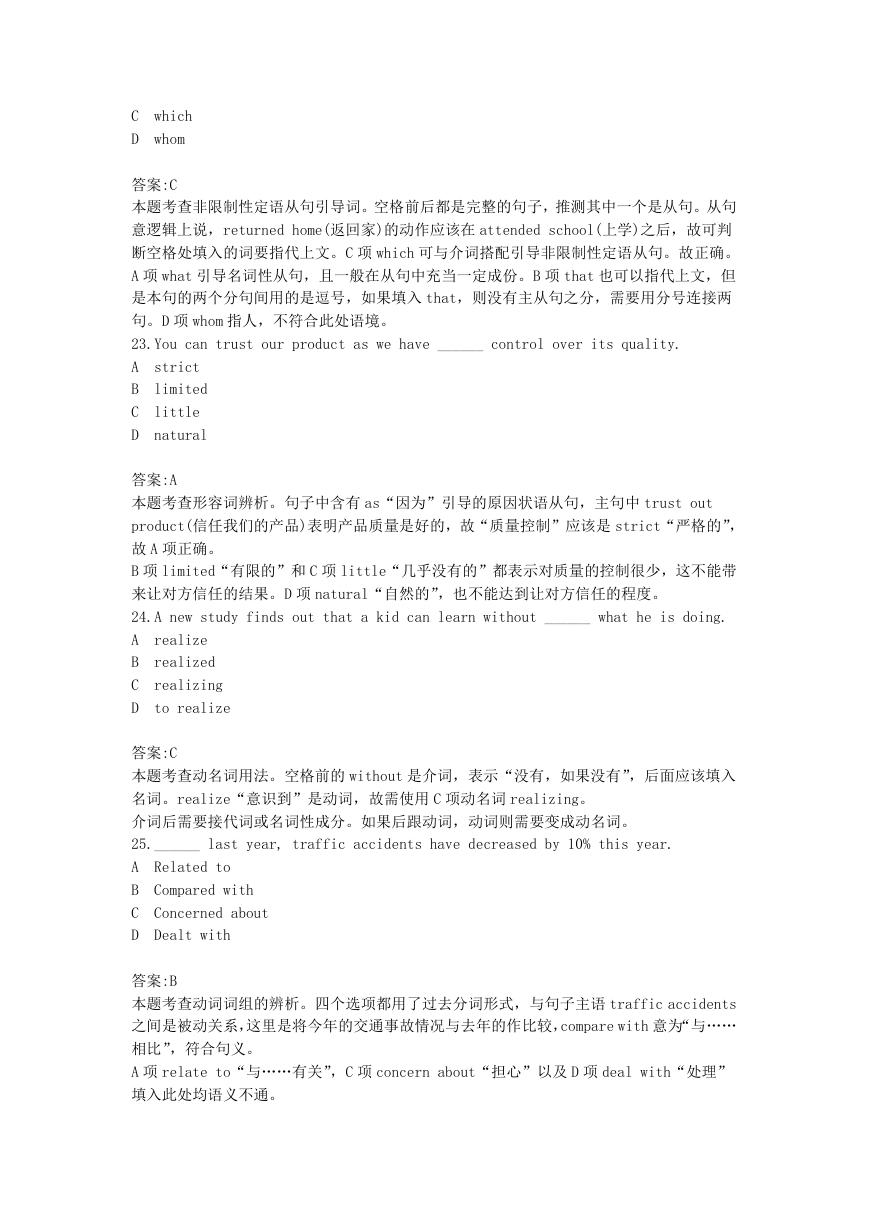
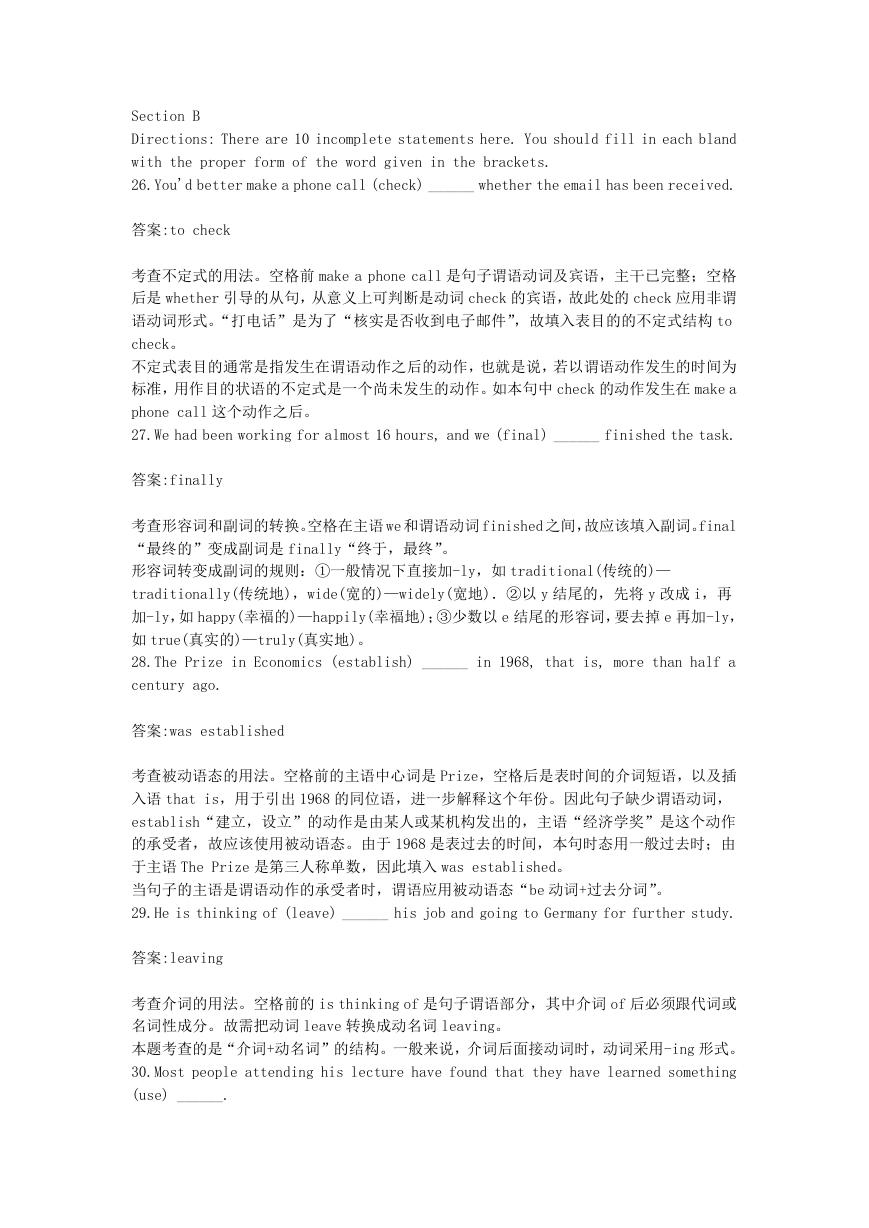








 2023年江西萍乡中考道德与法治真题及答案.doc
2023年江西萍乡中考道德与法治真题及答案.doc 2012年重庆南川中考生物真题及答案.doc
2012年重庆南川中考生物真题及答案.doc 2013年江西师范大学地理学综合及文艺理论基础考研真题.doc
2013年江西师范大学地理学综合及文艺理论基础考研真题.doc 2020年四川甘孜小升初语文真题及答案I卷.doc
2020年四川甘孜小升初语文真题及答案I卷.doc 2020年注册岩土工程师专业基础考试真题及答案.doc
2020年注册岩土工程师专业基础考试真题及答案.doc 2023-2024学年福建省厦门市九年级上学期数学月考试题及答案.doc
2023-2024学年福建省厦门市九年级上学期数学月考试题及答案.doc 2021-2022学年辽宁省沈阳市大东区九年级上学期语文期末试题及答案.doc
2021-2022学年辽宁省沈阳市大东区九年级上学期语文期末试题及答案.doc 2022-2023学年北京东城区初三第一学期物理期末试卷及答案.doc
2022-2023学年北京东城区初三第一学期物理期末试卷及答案.doc 2018上半年江西教师资格初中地理学科知识与教学能力真题及答案.doc
2018上半年江西教师资格初中地理学科知识与教学能力真题及答案.doc 2012年河北国家公务员申论考试真题及答案-省级.doc
2012年河北国家公务员申论考试真题及答案-省级.doc 2020-2021学年江苏省扬州市江都区邵樊片九年级上学期数学第一次质量检测试题及答案.doc
2020-2021学年江苏省扬州市江都区邵樊片九年级上学期数学第一次质量检测试题及答案.doc 2022下半年黑龙江教师资格证中学综合素质真题及答案.doc
2022下半年黑龙江教师资格证中学综合素质真题及答案.doc